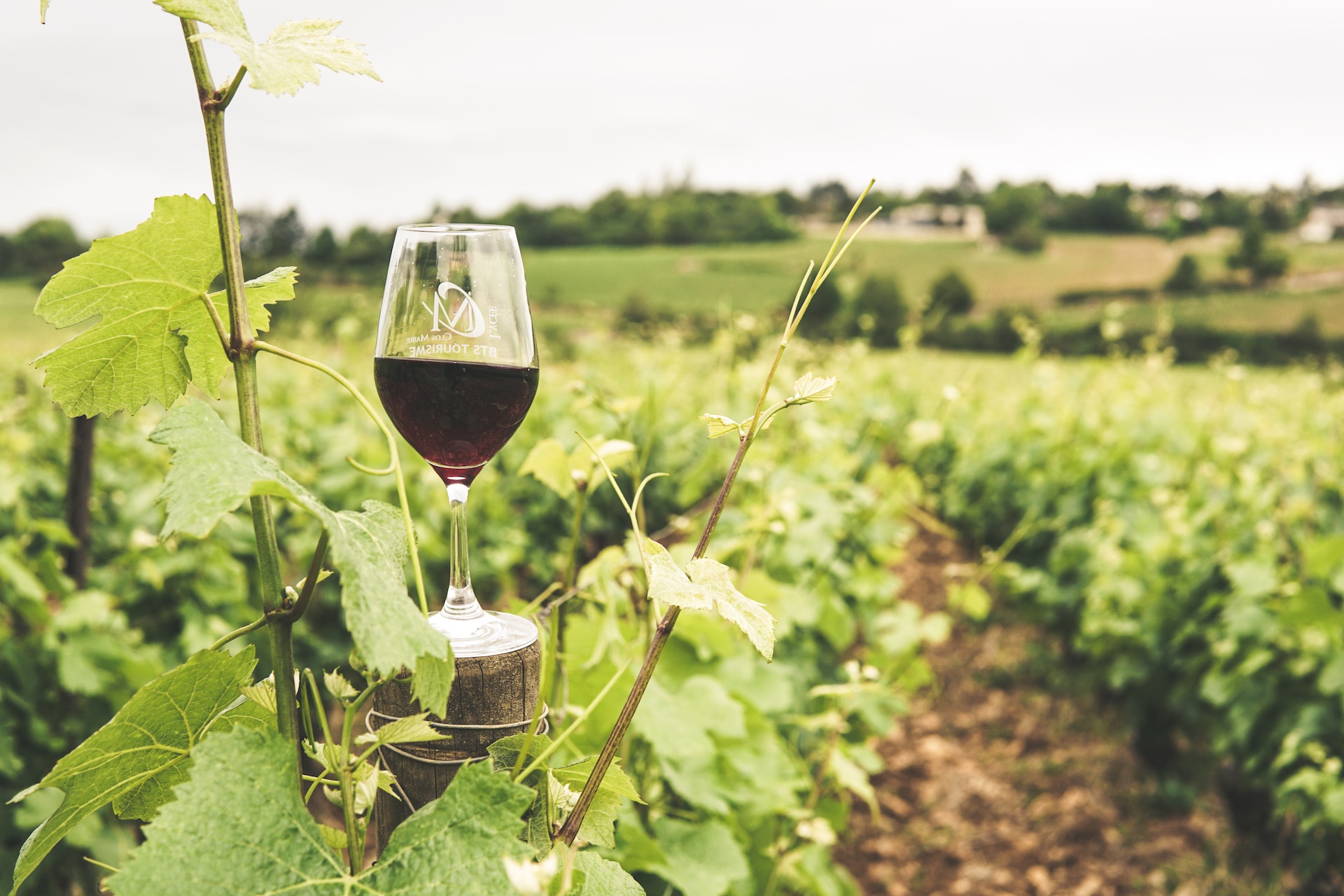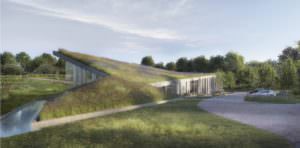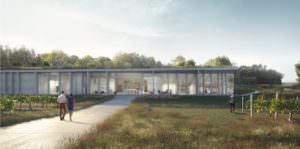
English Viticulture- our new landscape.

‘It is said that in wine there is truth’, (In vino veritas), and it seems fitting that during English Wine Week, taking place until Sunday (26 June), we raise a glass and discuss the impact of this dynamic and exciting new UK industry on our landscape.
Viticulture, the growing of grapevines, is an expanding market within UK crop production. According to the National Association for British and Welsh Wine Industry, there are over 700 vineyards (of which about 540 are commercial) ranging in size from small plots to large well-known wine producers. In total there are over 160 wineries producing world-class internationally award-winning sparkling, white, rose, and red wines.
A huge proportion of these are located in Sussex and Kent due to the chalky soil conditions and in recent times much warmer weather, which offers a good environment for grape growing. This is evolving our agricultural landscapes in a really interesting way, evolving from crops and grazing land that may offer more in the way of food security, to something that has more appeal, profile, and profit-making potential, particularly when aligned with the tourism aspects that viticulture can offer.
But it’s a tough industry that favours the brave, with annual success or failure heavily connected to the weather. But clearly a very successful industry with many high-profile new vineyards coming forward including one by Taittinger outside of the village of Chilham, a few miles from our Canterbury studio.
However, Viticulture has been accused of not doing enough to minimise carbon pollution and offset its emissions. Renowned viticulturalist Richard Smart poses this question in his article ‘Are Winemakers Environmental vandals?’ And as the National Farmers Union has set a net-zero goal for UK farming by 2040, what is the industry doing to minimise its impact?
EDLA colleagues Jade Goto, Georgia Timpson, and Eleanor Trenfield discuss the changing nature of our agricultural land and offer ideas for how we mitigate the environmental consequences of these new crops.
Our backgrounds and experience
Living in Kent and the Sussex Downs the emergence of high-quality vineyards in our surrounding areas is something we have observed with professional interest. In 2019, Jade undertook an extensive course at Plumpton College on the Principles of Vine Growing, to expand her theoretical and practical knowledge of Viticulture and also to gain a better understanding of the changes that she was witnessing across the landscape.
Because of the location of EDLA, much of the team’s understanding of Viticulture has come through observation of the surrounding landscape, including within The South Downs National Park (SDNP). The SDNP currently holds the largest percentage of vineyards in the UK, due to its soil, aspect, and climatic makeup. It is also one of the most sensitive landscapes, of the highest national designation in policy terms, so how the tensions are managed here is interesting to observe.
Living in Kent and the Sussex Downs the emergence of high-quality vineyards in our surrounding areas is something we have observed with professional interest.
Jade’s study coincided with a project that EDLA was engaged in, which combined the design of a small vineyard to be used as an educational resource as part of a wine importer’s new headquarters in Ashford (‘The Vinorium’).


The Vinorium proposed Concepts (Courtesy of Holloway Studios)
Our aim at EDLA is to support new vineyard projects from inception, so that we can advise on landscape sensitivities regarding the developments as a whole, collaborating with specialist viticulturists, to create schemes that will be optimal for the growers and producers, whilst having a positive impact, environmentally and visually, on the surrounding landscape, and support the thriving of our landscapes into the future.
How has Viticulture changed our landscape?
Historically, the South Downs and Kent landscapes have been farmed. The animals grazed and the crops grown have changed over time and this, in turn, has shaped the landscape. Both geographical and socio-economic aspects have influenced what and how humans have chosen to farm in this area and this point in history is no different. Climate change has seen temperatures rise and today’s agricultural industry has responded to this by adapting the crops that are grown.
Vineyards themselves do not physically appear to be very different to other forms of fruit production, however, it is the associated recreational aspects and income streams associated with the vineyards that will have a greater impact on how our landscapes are perceived and experienced. They also provide various employment opportunities, from picking to more skilled tourism-related employment.
In recent years, Viticulture has grown significantly. A 2021 research piece, undertaken by Vinescapes, estimated the scale of growth at a ‘90% increase in vineyard coverage in the South Downs National Park since 2016, with approximately five new vineyards planted every year.
“Climate change has seen temperatures rise and today’s agricultural industry has responded to this by adapting the crops that are grown.”
At this rate, the prediction is that the UK wine industry will continue to increase rapidly, with up to 34% of the South Downs National Park being suitable land for the growing of grapes. This is not confined to Sussex. Viticulture is one of the fastest-growing areas of agriculture across the UK.
The reason that the UK has not historically been a serious contender in the global wine industry, is that in the past is that the conditions for vine growing were not favourable. With increasing temperatures, the South Downs and parts of Kent now offer a similar growing climate to Champagne, which is ideal for sparkling wines.
With the recent news that Sussex wines have just been awarded protected status, joining Champagne and Burgundy, The South Downs is set to become an even bigger huge player on the Viticultural stage.
What is the bigger picture environmental impact of the growth of viticulture?
Viticulture has many of the same environmental impacts as any large-scale agronomical production. The creation of a vineyard still requires the removal of existing vegetation, and the implementation of a carefully controlled monoculture which is often maintained using a wide variety of pesticides, insecticides and fungicides. If you have ever seen a landscape dominated by vineyards, you will know how much physical alteration must go into the landscape in order to facilitate successful vine growth. Terraces into hillsides, drainage channels into valleys.
There is also the CO2 released into the air from fermentation to be accounted for, a study that looked at the strength of carbon emissions created during the wine fermentation found that a litre of juice produces 60 litres of carbon dioxide. Leading the study was Roger B. Boulton, a Professor in Chemical Engineering and Viticulture. He said, “As a winemaker, if you want to be a serious leader in sustainability then you have to capture your carbon emissions – a good way to do this is to turn it into chalk,”.
He goes on to cite that Spanish wine giant Torres has led the way in developing technology that successfully captures and transforms the carbon dioxide created during fermentation via its CCR (Carbon Capture and Reuse) programme.
Biodynamic viticulture considers the ecosystem surrounding the vineyard. Lunar cycles, soil health, biodiversity and natural pest control are all cornerstones of the biodynamic method.
Despite the challenges, there are some fantastic methods of growing grapes for wine that are becoming more popular. However, this is understandably a niche decision that does not have large-scale commercial traction, given that the margins between success and failure of a harvest can be so slim.
Biodynamic viticulture considers the ecosystem surrounding the vineyard. Lunar cycles, soil health, biodiversity and natural pest control are all cornerstones of the biodynamic method. Livestock are used to manage weeds, and grassland around the vines and provide natural fertilizer; the lunar cycle dictates the growth and harvest cycle rather than the demands of the grower. Space is given for wild growth, and irrigation is kept to a minimum.
With any form of agriculture, there has to be an ongoing awareness and understanding of how our use of the land can have a negative impact on the natural environment. Wildlife habitats, the soil and the water courses need protection.
This needs to be a major part of the design process and the thinking behind any new venture. This high-level awareness of ecological factors then needs to continue into the future management and maintenance of these developments.
Overall, outside of climate consequences, the negative impacts of viticulture are the same as any other agriculture practice that creates a monoculture that is overly managed.
What landscape factors need to be considered in the selection of sites and production?
An understanding of the specific site, its constraints and opportunities and the landscape character is essential, as is an in-depth look at the potential economic investment and rewards. The quality of a wine will depend on the site, climate, vine and rootstock variety and viticultural practices. The most crucial decisions when creating a Vineyard include where and what you plant.
The microclimate of a site is assessed on temperature, frost risk, sunshine and rainfall. Site-specific influences on vine growth are the aspect, altitude, topography, wind exposure, surrounding landscape features and the soil. But temperature is the most principal factor in cool climate viticulture and the site will ideally fall within the upper and lower temperature range of 10-20c. The temperature of a site will influence the species chosen.
The climate of a site is evaluated on three levels; Macroclimate, that of region or country; Mesoclimate, that of area or field and Microclimate, the space immediately around the plants’ leaf canopy.
Frost can be managed passively, before the risk of frost to prevent damage or actively, during a frost. Passive management can include low-risk site selection, cold air drainage, a later budding cultivar of vine and pruning height. Active frost protection includes wind fans and electric cables.
The quality of a wine will depend on the site, climate, vine and rootstock variety, and viticultural practices. The most crucial decisions when creating a Vineyard include where and what you plant.
Sunshine hours will affect the growth success of Vitis vinifera and the ideal aspect for slopes is south-facing. 1250 hours of sunshine are required to ripen the fruit and sunshine hours decrease as you move away from the South coast, if the site is near to a large city or if the site is shaded.
The UK produces more rain than is required by the vines, so here drainage is more important than irrigation. This can be done by improving the soil structure and creating ditches and drains.
Wind protection is important, as a windbreak will improve the micro-climate temperature and reduce wind damage. However, it is important that the windbreak does not shade the plants or increase frost risk. If trees are being planted as a windbreak, they must be planted several years before the vines. Tree planting is also a good opportunity for wildlife corridors.
In 2021, the South Downs National Park Authority published a planning TAN (Technical Advice Note) to guide prospective vineyard developers on planning matters. This document outlines the wider context of vineyard development, rather than the site specifics. It states that Viticulture is both a form of farming and a new enterprise. The South Downs has always been a living, working landscape that supports local communities but one that needs to be protected from any adverse impact of a new industry.
The long-term outcomes for this particular area, focus on conserving and enhancing the landscape’s natural beauty and character, wildlife habitats, soil and water and tree management. The development of new vineyards needs to join up with these strategies. The thinking and planning from inception need to be aware and sensitive and if this is done correctly, hopefully, the adverse effects of viticulture will be minimised and the overall impact on the surrounding landscape and communities will be one that is beneficial.
What visual impact do vineries have on the landscape?
The vineyards that can now be seen as you drive through the countryside, are reminiscent of journeys through Europe. As well to the visual aspect, there is also the human and economic aspect. Conversations with people who work at, dine at, tour and buy from local vineyards have become a frequent part of daily life.
There are bigger considerations than just the vineries though, as many vineyards are also associated with visitor centres and tourism.
By the nature in which vines are grown, in upright rows, only about 20% of any vineyard floor is the vine plant. Traditionally, the land between the vines is grass or wildflowers. The vineyard alleys are a prime area for considered planting of wildflowers and grasses that will enhance biodiversity. In addition to these wildlife strips, hedges, trees and soil-enhancing planting are living elements that can be incorporated into the landscape design. Therefore, the soft visual aspect of the vineyards, if planted traditionally, can have a natural beauty.
The vineyards that can now be seen as you drive through the countryside, are reminiscent of journeys through Europe.
If the vines can be laid out in smaller, appropriately located areas, rather than dominating a landscape that may have experienced largescale field pattern loss, they can be designed to seamlessly merge with the surrounding landscape and maintain open vistas.
However, in terms of the infrastructure that is required for the winemaking process, visitor centres, accommodation etc; the site needs to be considered both contextually and holistically with a sympathetic, landscape-led approach to the positioning of the visitor facilities, roads and wine-making infrastructure. For each project, a specialist team needs to work closely together to create a sensitive thoughtful design that reduces the impact on the natural landscape.
When done well, these vineyards have the ability to bring in gentle tourism that connects people to the landscape, increases employment, educates and ideally works in tandem with the natural environment.
As long as there is a balanced and environmentally considered approach, we are sure that Dionysus, son of Zeus and the God of Wine, would join us in celebrating the growth of the UK wine industry and the transformation of the landscape around us.
We will drink to that! Cheers.
Wine Favourites of the Contributors:
Eleanor’s favourite tipple is Chapeldown’s English Rose, (it brings back happy memories of her wedding), Jade is partial to Wiston Estate Brut and Georgia’s go-to is grape is Barnesole Classic Reserve, as she grew up next to the vineyard.
